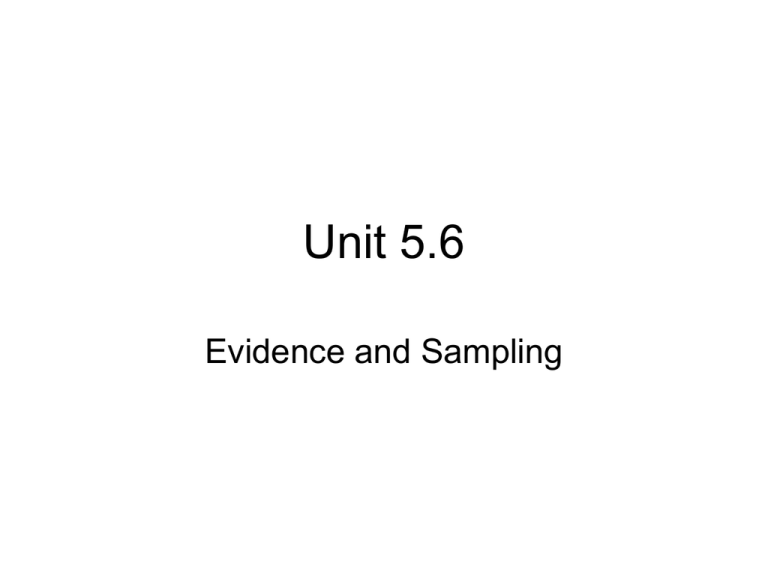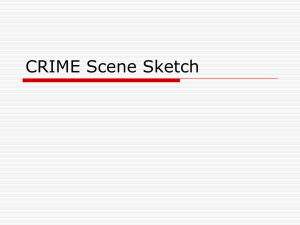Unit 5.6: Evidence & Sampling
advertisement

Unit 5.6 Evidence and Sampling Objectives – – – – – – – Evaluation of the scene Scene photography Scene search Scene sketching techniques Sample collection Sample packaging Tracking and chain of custody Important Fact • As first responders you are the only people who view the crime scene in its original condition! Evidence • Any object or material which a suspect or victim leaves at a crime scene, takes from a crime scene, or which otherwise may be connected with a crime. Importance of proper preservation and handling – Potential high exposure incidents • • • • • • Environmental crimes Clandestine lab operations Terrorism Lawsuits Chemical suicides Other crime scenes Proper sampling – Helps in • • • Determine material identity Laboratory analysis “gold standard” Public safety analysis – Proper collection/handling – Proper transfer/analysis Concerns about location – – – – A crime scene An incident with significant liability concerns Extensive cost recovery considerations Exposure documentation purposes for employee or bystander health reasons Responders – Jobs made difficult by: • • • Critical response time Perform duties while considering evidence Need to get people, equipment and yourself out without destroying evidence FBI 12 step process – Step 1: Preparation • Pre-incident activities necessary to prepare for the sampling mission – Step 2: Approach of scene • • • During response to the scene, obtain as much additional awareness as possible Once on scene, review any existing site safety plans or incident action plans that has already been developed Begin developing your size-up as to potential resource needs and safety issues that may be present FBI 12 Step – Step 3: Protection of scene • • • • Isolate the immediate scene and evacuate any endangered individuals Removal of non-essential personnel Securing scene (barrier control) Search warrant considerations FBI 12 Step – Step 4: Preliminary survey • • • • Safety considerations Cursory search identifying obvious items of evidence Create a “game plan” Complete a rough sketch FBI 12 Step • Step 5: Evaluation possibilities – – – – Is going to be scene dependent Samples must be sufficient to either: Do not attempt to sample everything Develop a written sampling plan FBI 12 Step • Step 6: Prepare narrative – – – – – Record pertinent data immediately Arrival Actions taken Personnel present Presence of evidence that was visible without searching – Scene entry FBI 12 Step • Step 7: Depict scene photographically – Videotape – Photography – Depictions • Step 8: Diagram scene – Rough sketch • • Final sketch Methods FBI 12 Step • Step 9: Conduct sampling – – – – – – – – Assemble necessary supplies Establish and communicate objectives to sampling team during pre-entry briefing Prepare personnel Use proper approach and maintain safety awareness Aseptic techniques Sampling primary containers For all samples A “blank” or “control” container for each primary sample container FBI 12 Step • Step 10: Record and collect – All samples shall have and maintain individual chain of Custody – All individual samples are then transferred to and maintained by an evidence custodian FBI 12 Step • Step 11: Final survey – Final entry is made into the area to ensure that all necessary samples have been collected and that all safety issues have been addressed. – This review may include a detailed additional search to ensure no items of evidence have been overlooked. FBI 12 Step • Step 12: Release of scene – – – – – Proper disposal of hazardous waste will be a primary concern Hazardous waste is generally segregated and disposed of based upon hazard class Scene is released to property owner/contractor or other agency. Hazards present must be clearly communicated to the receiving authority. Any re-entry by law enforcement or fire personnel may require a new search warrant. Management of Sampling • Incident response timeline – Pre-event planning (FBI Step 1) – Response phase (FBI Step 2) – Termination phase (FBI Steps 11 & 12) • Considerations – Representative sample – Appropriate amount of sample – Contamination of sample Sample with Purpose – – – – – – Waste disposal classification Screening Identify hazards Determine risk Sample should be “targeted” Eventual prosecution Guidance – EPA SW 846 – NIOSH Handbook of Analytical Methods – Florida Comprehensive Emergency Management Plan — Biological Response Policy – Florida SERC Hazardous Materials Sampling Model Procedure Quality Assurance • Quality assurance plan • • Written site specific sampling plan • • • • • Policy and procedures Limits down range time Defines objectives Reinforces quality control Identifies supplies needed Blanks • • • Taken down range Not opened Handled as real samples Equipment • Initial Detection • • • • • pH Radiological CWA detection Combustibility/O2 PID Equipment • Downrange screening • • • • • • • • • Rayon/Dacron swabs Copan© swabs PBS with Tween 20 De-ionized/distilled water Parafilm®/Teflon tape Kill bucket Documentation supplies Decontamination supplies Labels/seals/vials/overpacks/bags – Tools • • • Liquid sampling tools Dry sampling tools Gas/vapor sampling tools









